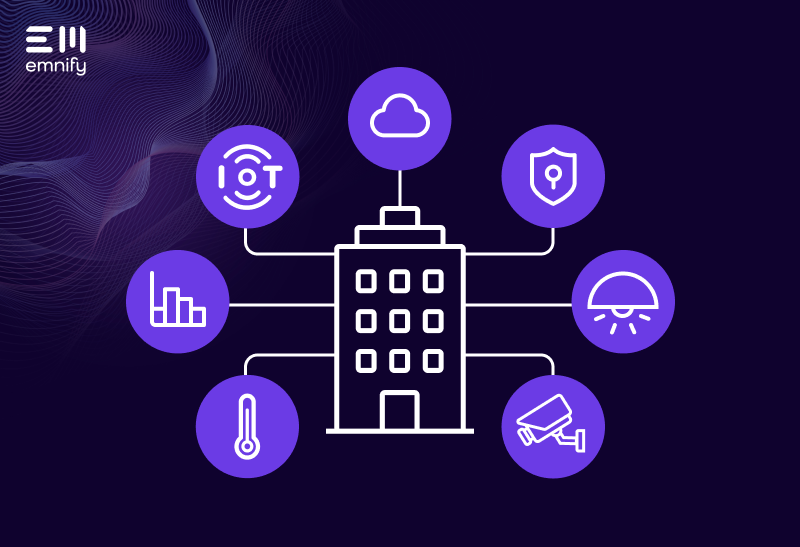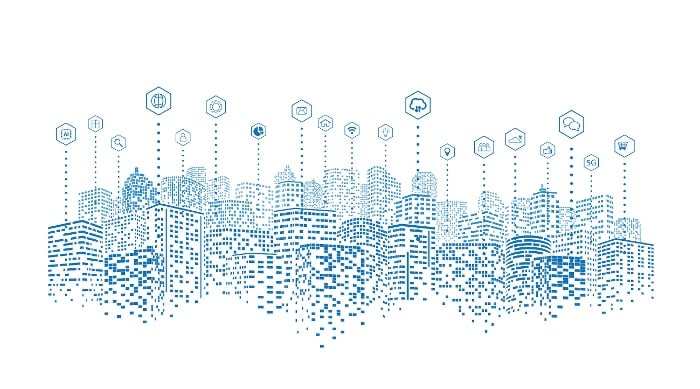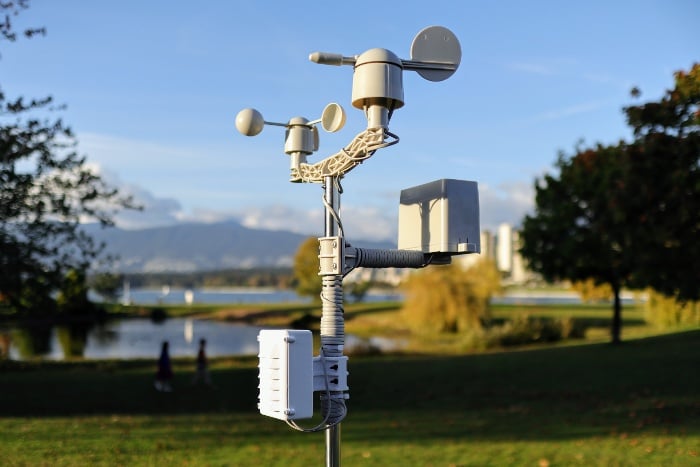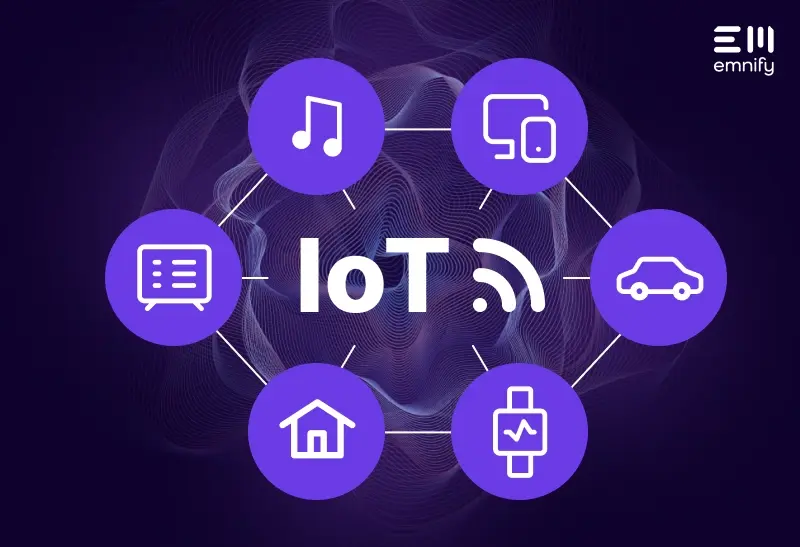

Quick definition: A smart building, enhanced by IoT technology, is an interconnected structure where integrated and automated technologies improve efficiency, safety, and comfort. Smart building IoT solutions power building intelligence and revolutionize how these buildings are managed and function, benefiting owners, managers, and occupants with advanced, data-driven control.
Understanding smart building IoT
The Internet of Things (IoT) is reshaping how commercial and residential buildings operate, bringing about an era of smart buildings - buildings that are more efficient, safer, and more comfortable for their occupants.
In a nutshell, a smart building is a type of facility or space in which technologies are put in place to automate different processes. A smart building, in the context of IoT, is an intelligent ecosystem that continuously adapts and responds to its inhabitants and the environment.
This is all made possible by a network of IoT devices that work in unison to enhance building operations. These devices range from simple sensors monitoring temperature and air quality to sophisticated systems managing energy use and security.
Feeding real-time data to a central dashboard hub, IoT technology delivers smart insights, to help better understand buildings, ensuring the safety and integrity of all facilities and the wellbeing of the people working or living in that environment.
Let’s see how IoT can make that happen.
Key IoT applications in smart buildings
Building temperature control
 IoT in smart buildings enables real-time temperature monitoring, analytics, and automated control using networked devices, sensors, and communication protocols, resulting in more accurate and dependable data for crucial decision-making. For example, power outages may be avoided if temperature fluctuations in transformers are spotted in advance so that repairs can be made.
IoT in smart buildings enables real-time temperature monitoring, analytics, and automated control using networked devices, sensors, and communication protocols, resulting in more accurate and dependable data for crucial decision-making. For example, power outages may be avoided if temperature fluctuations in transformers are spotted in advance so that repairs can be made.
Climate change, aging infrastructure, energy security, and price volatility are just some of the issues that might be mitigated with its implementation.
Fire detection and emergency response
 The integration of IoT in fire detection systems transforms traditional safety measures into a sophisticated network of early warning and rapid response capabilities.
The integration of IoT in fire detection systems transforms traditional safety measures into a sophisticated network of early warning and rapid response capabilities.
Advanced sensors, capable of detecting early signs of fire such as smoke or unusual heat patterns, are seamlessly integrated into the building's management systems. This integration allows for instant alerts to occupants and emergency services, drastically improving safety outcomes.
An IoT-enabled system provides detailed information, like the exact location of smoke detectors triggering or heat detectors signaling anomalies, and can even identify when a water flow switch activates in response to a fire.
This level of detailed monitoring and data analysis not only ensures quicker emergency responses but also aids in preventive maintenance by identifying potential hazards before they escalate into emergencies.
Moreover, in the context of increasing urban density and the need for efficient emergency management, such IoT applications in fire detection play a crucial role in ensuring the safety and well-being of building occupants.
Access control systems
 Modern access control systems, at their core, rely heavily on IoT technology.
Modern access control systems, at their core, rely heavily on IoT technology.
In these advanced systems, each component - be it locks, access controllers, card readers, or other devices - is assigned a unique IP address, enabling seamless communication within the network.
This interconnectedness allows for sophisticated functionalities, like real-time monitoring of employee access, visitor management, and even integration of emergency evacuation protocols.
An example of IoT's impact is its role in enhancing security in sensitive areas by enabling biometric authentication or smart card access, ensuring that only authorized personnel can enter restricted zones.
Furthermore, IoT-driven access control systems offer the flexibility of remote management, allowing administrators to modify access rights or receive security alerts in real-time, no matter where they are. This not only enhances security but also streamlines operations, making these systems invaluable in today's fast-paced, security-conscious environments.
Burglar alarm systems
 In smart buildings, IoT-based burglar alarm systems offer a comprehensive security framework.
In smart buildings, IoT-based burglar alarm systems offer a comprehensive security framework.
Occupancy monitoring is a key feature, providing detailed insights into facility usage through automated, efficient tracking. This not only enhances safety but also helps identify unusual patterns that could indicate security threats.
Door and window monitoring systems enhance this by offering real-time alerts for entries, contributing to controlled access and potentially optimizing other operations like cleaning schedules.
Furthermore, IoT-driven access control systems utilize advanced identification technologies, including smart locks and facial recognition, for secure and tailored access.
Beyond intrusion prevention, these systems extend to preventative maintenance, ensuring the security of the building's infrastructure by monitoring equipment health and enabling proactive interventions, thereby minimizing downtime and maintaining operational integrity.
Real-world examples of smart buildings IoT
Let’s look at two real-world applications to better understand the impact and possibilities of IoT in smart buildings.
Clarity's air quality monitoring
 Clarity, a company based in Berkeley, USA, has redefined air quality management. Leveraging IoT for sensing pollutants, they have made air quality monitoring more accessible and actionable. With emnify’s global IoT SIM, Clarity has significantly improved cities’ air quality data footprint.
Clarity, a company based in Berkeley, USA, has redefined air quality management. Leveraging IoT for sensing pollutants, they have made air quality monitoring more accessible and actionable. With emnify’s global IoT SIM, Clarity has significantly improved cities’ air quality data footprint.
This solution is a great example of optimized environmental management, offering scalable, efficient pollutant monitoring in over 55 countries, including areas where monitoring was previously unavailable.
Metr’s building management innovation
![]() Berlin-based startup Metr illustrates the potential of IoT in property technology (PropTech). Their intelligent building management platform and IoT gateway, m-gate, revolutionize the management of living spaces.
Berlin-based startup Metr illustrates the potential of IoT in property technology (PropTech). Their intelligent building management platform and IoT gateway, m-gate, revolutionize the management of living spaces.
By digitalizing building systems, Metr enhances efficiency and sustainability. Partnering with emnify, Metr connects over 800 m-gates in the DACH region, enabling seamless data transmission from utility systems to their platform. This showcases the power of IoT in transforming traditional building management into a more efficient, data-driven approach.
The future of smart buildings with IoT
IoT has redefined efficiency, safety, and sustainability in urban spaces, turning buildings into dynamic environments that adapt to the needs of occupants and management alike.
Advancements in IoT technologies promise even more integrated, efficient, and sustainable solutions.
The emergence of 5G, enhanced AI algorithms, and more sophisticated sensors will further change how buildings operate and interact with their environment.
emnify’s SuperNetwork is at the forefront of this transformation. By offering redundant IoT connectivity and a global reach across 540+ networks in 180+ countries, it's poised to be a key enabler in this evolution.
The SuperNetwork's seamless integration of cellular and now satellite connectivity ensures that smart buildings remain operational and interconnected, even in the most remote areas.
This robust infrastructure is vital for the continued advancement and reliability of smart building technologies, paving the way for a future where buildings are not just smart, but also adaptive and responsive to their occupants' needs.
Get in touch with our IoT experts
Discover how emnify can help you grow your business and talk to one of our IoT consultants today!

With a career spanning over 18 years in storytelling and content creation, Bronwyn translates technical concepts and ideas into snackable and easy-to-digest content.


